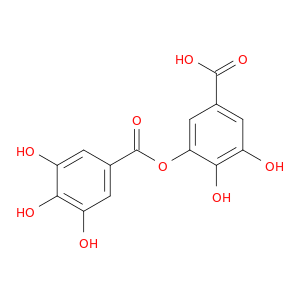
DIGALLIC ACID
| Title | Journal |
|---|---|
| Functional swapping between transmembrane proteins TMEM16A and TMEM16F. | The Journal of biological chemistry 20140314 |
| Digallic acid from Pistascia lentiscus fruits induces apoptosis and enhances antioxidant activities. | Phytotherapy research : PTR 20120301 |
| Investigation of the apoptotic way induced by digallic acid in human lymphoblastoid TK6 cells. | Cancer cell international 20120101 |
| In vitro anti-uveal melanoma activity of phenolic compounds from the Egyptian medicinal plant Acacia nilotica. | Fitoterapia 20111201 |
| TMEM16A inhibitors reveal TMEM16A as a minor component of calcium-activated chloride channel conductance in airway and intestinal epithelial cells. | The Journal of biological chemistry 20110121 |
| The inhibition of the mammalian DNA methyltransferase 3a (Dnmt3a) by dietary black tea and coffee polyphenols. | BMC biochemistry 20110101 |
| Novel strategies for upstream and downstream processing of tannin acyl hydrolase. | Enzyme research 20110101 |
| Inhibition of Ca2+-activated Cl- channels by gallotannins as a possible molecular basis for health benefits of red wine and green tea. | FASEB journal : official publication of the Federation of American Societies for Experimental Biology 20101101 |
| Hydrolysable tannins depress cardiac papillary muscle contraction and propranolol-induced negative inotropism. | Fitoterapia 20101001 |
| Study of genotoxic, antigenotoxic and antioxidant activities of the digallic acid isolated from Pistacia lentiscus fruits. | Toxicology in vitro : an international journal published in association with BIBRA 20100301 |
| Green tea catechin, epigallocatechin gallate, suppresses signaling by the dsRNA innate immune receptor RIG-I. | PloS one 20100101 |
| Plant polyphenols as dietary antioxidants in human health and disease. | Oxidative medicine and cellular longevity 20090101 |
| Cytotoxic effects of digalloyl dimer procyanidins in human cancer cell lines. | The Journal of nutritional biochemistry 20081201 |
| Effects of grape cell culture extracts on human topoisomerase II catalytic activity and characterization of active fractions. | Journal of agricultural and food chemistry 20050406 |
| Comparative analysis of phenolic acids in mistletoe plants from various hosts. | Acta poloniae pharmaceutica 20010101 |
| Depsides and depsidones as inhibitors of HIV-1 integrase: discovery of novel inhibitors through 3D database searching. | Journal of medicinal chemistry 19970314 |
| Differential inhibition of reverse transcriptase and various DNA polymerases by digallic acid and its derivatives. | Journal of natural products 19900101 |